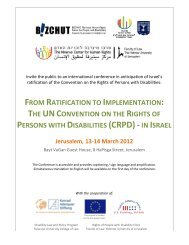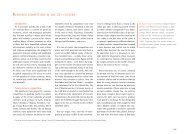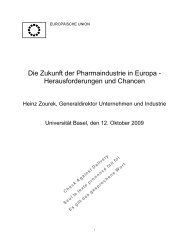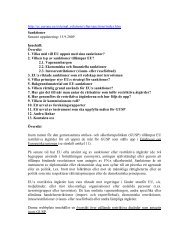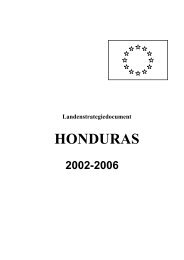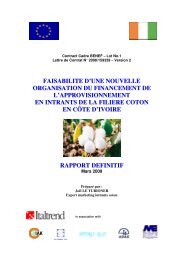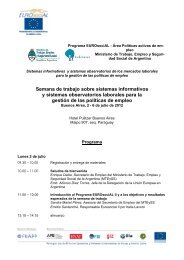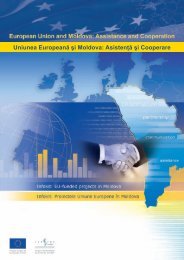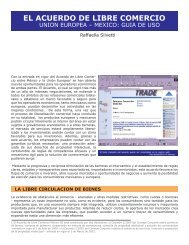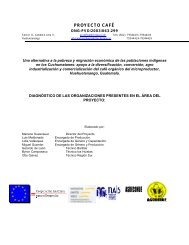Bhutan Country Strategy Paper 2007-2013 - the European External ...
Bhutan Country Strategy Paper 2007-2013 - the European External ...
Bhutan Country Strategy Paper 2007-2013 - the European External ...
You also want an ePaper? Increase the reach of your titles
YUMPU automatically turns print PDFs into web optimized ePapers that Google loves.
ANNEX IV: <strong>Country</strong> Environment Profile (summary)<br />
<strong>Bhutan</strong> is endowed with a relatively pristine environment, boasting a high percentage of forest<br />
cover and very high levels of biological diversity at <strong>the</strong> ecosystem, species and genetic levels. To<br />
conserve <strong>the</strong> country’s forests and biodiversity, <strong>the</strong> RGoB has proclaimed over 26 percent of <strong>the</strong><br />
land area protected, <strong>the</strong> highest percentage of protected area in <strong>the</strong> world. The country is governed<br />
by stringent environmental standards and a strong conservation ethic. Since <strong>the</strong> 1970s, <strong>the</strong> Royal<br />
Government of <strong>Bhutan</strong> (RGoB) has put in place a comprehensive environmental policy and<br />
regulatory framework. The country has adopted a “middle path” approach, balancing conservation<br />
and economic development and ensuring that <strong>the</strong> spiritual, cultural and social needs of <strong>the</strong> society<br />
are carefully considered.<br />
Despite <strong>the</strong> country’s unique environmental status, a number of factors threaten <strong>Bhutan</strong>’s<br />
environment, including <strong>the</strong> accelerating pace of <strong>Bhutan</strong>’s own development, <strong>the</strong> high population<br />
growth rate, and <strong>the</strong> recent rise in rural-urban migration, which has led to challenges with urban<br />
waste management, air and water pollution, and urban planning. The main impacts of <strong>the</strong>se threats<br />
include increasing loss of biological diversity, reduction of forest area, degradation of ecosystem<br />
services and reductions in air and water quality. Climate change and associated natural disasters<br />
compound <strong>the</strong>se threats and present additional challenges for <strong>Bhutan</strong>’s environment.<br />
<strong>Bhutan</strong>’s development planning is critical to <strong>the</strong> protection of its resources. Since opening to <strong>the</strong><br />
outside world in <strong>the</strong> 1960s, <strong>the</strong> country has articulated its development plan in nine five-year plans<br />
(FYP). The Ninth Plan (July 2002-June <strong>2007</strong>) is currently under implementation. Its goals revolve<br />
around hydropower development, increased food self-sufficiency and industrial development.<br />
Priorities include: (a) improving and expanding <strong>the</strong> road network to improve farmers’ access to<br />
markets; (b) expanding power transmission lines to facilitate export of power and promote growth<br />
of power intensive industries; (c) improving urban infrastructure, particularly housing, and related<br />
demand for services; and (d) modernisation of agriculture to enhance agricultural productivity.<br />
If not carried out in a sustainable manner, some of <strong>the</strong> larger planned investments (e.g. road<br />
construction, industrial development, housing construction, rural electrification) in <strong>the</strong> Ninth Plan<br />
could result in serious short and long-term damage to <strong>the</strong> environment, as well as <strong>the</strong> economy.<br />
However, bigger impacts could result from <strong>the</strong> potential cumulative impacts of many smaller<br />
development proposals, as well as development projects that have not been articulated in <strong>the</strong> Plan.<br />
The impacts of <strong>the</strong>se development projects depend on <strong>the</strong> government’s ability to regulate <strong>the</strong><br />
environment. Institutionally, <strong>the</strong> environment is strongly represented in <strong>Bhutan</strong>. The National<br />
Environment Commission Secretariat (NECS) is <strong>the</strong> focal agency for all environmental issues. Its<br />
responsibilities include <strong>the</strong> overall formulation and monitoring of environmental policy and<br />
legislation. Line ministries, dzongkhags and gewogs, and private companies are responsible for <strong>the</strong><br />
implementation of environmental assessments and ensuring compliance to environmental<br />
regulations. However, environmental management at <strong>the</strong> central level tends to be<br />
“compartmentalised” within sectors, leading to incompatibilities between sector investments plans.<br />
Cross-sectoral planning with regard to environmental issues is necessary to overcoming this<br />
problem.<br />
<strong>Bhutan</strong> is divided administratively into 20 dzongkhags and 201 (blocks). A gewog is <strong>the</strong> smallest<br />
administrative unit within a district. The Ninth FYP emphasises shifting formerly national<br />
environmental policy tasks, such as development planning, allocation of resources, and framing<br />
and implementing rules and regulations to <strong>the</strong> dzongkhag and gewog levels. This will empower<br />
officials at <strong>the</strong> local level, and will provide both opportunities and constraints for effectively and<br />
26




